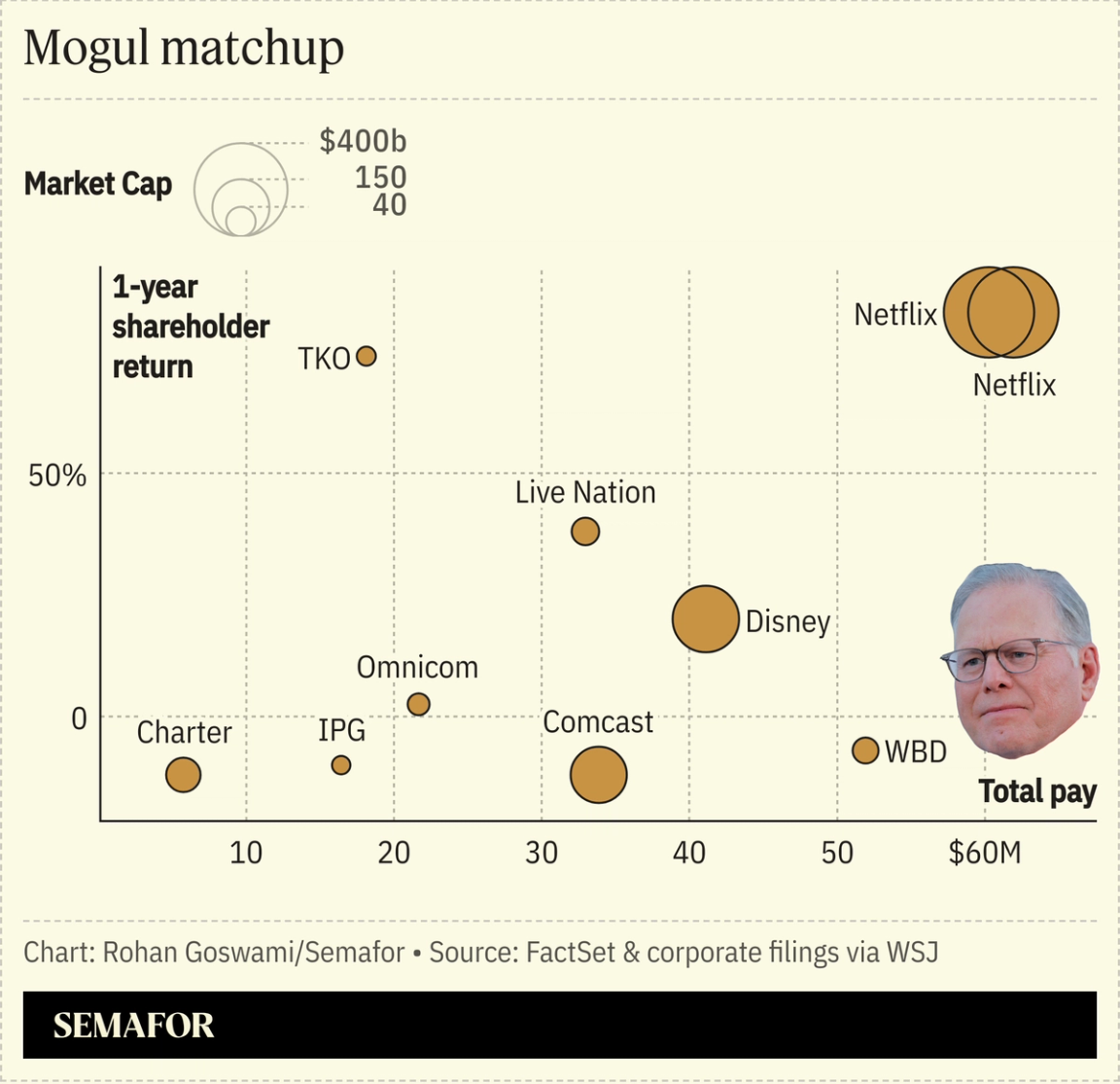| | In today’s edition: a new news site covering extremism, and a revealing split in how Americans get t͏ ͏ ͏ ͏ ͏ ͏ |
| |   New York New York |   Washington Washington |   Portland, ME Portland, ME |
 | Media |  |
| |
|
 - WBD for sale
- Mixed Signals
- Active/passive consumption
- Weiss’ calendar
- Right-wing beef
- Anti-authoritarian data
- NPR vs. CPB
|
|
 A few years ago, then-teenager Nick Shirley was an amateur vlogger making elaborate prank videos with high school buddies: antics like putting dry ice in a truck bed or sneaking into a wedding. Sometimes, he’d tweet zero-engagement man-on-the-street clips to editors at CNN and HuffPost, offering to sell tape from high-profile events, including the Capitol riots on January 6. Shirley is now a face of Donald Trump’s new media, boasting nearly a million subscribers on YouTube. He is one of two influencers who in recent months posted videos from Manhattan’s Canal Street showing mostly African migrants selling knockoffs of designer goods to tourists and out-of-towners, as the locals (our New York team among them) weave through the crowd. Last Sunday, Savanah Hernandez, a former InfoWars staffer, tagged ICE in a video of the scene. Less than 48 hours later, ICE shut down the block, barreling down Broadway against one-way traffic in armored vehicles, triggering national media attention and immediate protests. Shirley had stumbled onto the Canal Street vendors while in New York making a video about Zohran Mamdani. He told me he wasn’t aware of whether DHS saw his content, and the agency declined to comment on whether the influencers played any sort of role in the raid, citing “operational security.” But it’s a plausible assumption. In the long-gone days of the mainstream media, top New York Times editors might brief legislators about a big investigation, and get the scoop when they introduced a remedy. Now, the administration takes its cues when tagged in posts from the grassroots right, and federal force can follow vertical videos. The Trump administration “has seen how unreliable the Fake News media is and how much chaos they created with lies,” Laura Loomer, the face of this new form of media activism, texted me. “They have come to see first hand how much more accurate and reliable the independent media is.” Also today: A new news site covering extremism, Bari Weiss and Will Lewis look for conservative stars, and a revealing split in how Americans get their news. |
|
The WBD M&A drama continues |
 As various media titans contemplate bidding for Warner Bros. Discovery, CEO David Zaslav’s main job is to get a good price. And to do that, he’ll need to create the “on-screen magic of a competitive auction,” Semafor’s Liz Hoffman writes. “The shortlist of potential bidders, meanwhile, appear ambivalent, unprepared, or both,” she writes. “Comcast is interested in … something … but two days in, there’s not even a public promise to take a look.” And Netflix’s Ted Sarandos has no interest in cable, but WBD’s movie studios have also gotten little response from the streamer. Those companies or others may still eventually try to outbid Paramount, which offered a reported $60 billion for WBD. But as M&A talks continue, Liz writes, the media business is “no more immune from the resulting chaos than industrial giants that went through this a decade ago.” One thing that seems certain: Zaslav is going to get paid. He stands to make about $500 million if Paramount’s bid goes through, Rohan Goswami reports. |
|
 American Eagle’s summer campaign with Sydney Sweeney blew up in ways no one could’ve imagined, but chief marketing officer Craig Brommers knew it was going to hit a cultural nerve. This week, Ben and Max bring on the AE CMO to give us an inside look into the “Great Jeans” campaign, what he made of the controversy that surrounded it, and how Donald Trump and JD Vance boosted their sales. They also discuss how marketing today is like running an entertainment company, why he ignored the advice of what he calls the “crisis communication industrial complex,” and whether AE’s campaign with Travis Kelce was timed to Kelce’s engagement to Taylor Swift. |
|
Seeking out vs. scrolling by |
A key fault line in American politics may be whether someone is an “active” or a “passive” news consumer. According to a survey by Global Strategy Group first shared with Semafor, people classified as active consumers — those who seek out the news — tended to be older cable news viewers. Passive consumers — people who let news come to them — tended to be younger, to rarely watch live television, to be unvaccinated against COVID-19, or to consider themselves politically independent or non-MAGA Republicans. Still, active news consumption cut across party lines: 67% of “strong Democrats” and 64% of voters who identified as “MAGA Republicans” were active news consumers, compared to about 60% of voters overall.  “This very potentially politically influential audience is disproportionately on these algorithm-driven social media platforms, and that’s where they’re increasingly getting their understanding and information about current events,” Will Jordan, one of the study’s authors, told Semafor in an interview. “In many ways, 2024 was a sort of expression of how much political impact that can have, with all the swings you saw among young people, among working-class people, among people who are less engaged in politics.” |
|
Weiss meets with CNN’s conservative |
 Ken Cedeno/Reuters Ken Cedeno/ReutersStatus reported last week that Bari Weiss, weeks into her tenure as editor-in-chief of CBS News, had approached Fox News anchor Bret Baier about a potential role hosting the network’s flagship evening news program. But Baier isn’t the only person from the world of conservative media that Weiss has been speaking with, Semafor has learned: CNN personality Scott Jennings, Trump’s main defender on the network, visited Weiss this week at CBS’ New York headquarters. It’s unlikely that Weiss will succeed in plucking Baier from his longtime perch atop Fox News’ evening broadcast. And staffers are still adjusting to her leadership. |
|
 If you like Semafor Media, you should take a look at Numlock News. Numlock is a daily newsletter that pops out fascinating numbers buried in the news. Each issue is full of great stories that you’re missing out on, including under the radar science and culture news as well as amazing data journalism that’s drowned out by the loud stuff. Enjoy catching up on the world each morning with Numlock news — check it out today. |
|
Data reporters launch extremism outlet |
 Marco Bello/Reuters Marco Bello/ReutersOn Monday, former Bellingcat journalist Tristan Lee and open-source researcher Jennefer Harper will launch a new digital publication covering “authoritarian and anti-democratic movements, with a particular focus on the far-right.” It’s an outgrowth, Lee said, of the de-emphasis of reporting on the far right at many American news organizations. “At a time when masked agents of the state act with impunity, emboldened neo-Nazi groups march in the streets, and one institution after another legitimizes authoritarian consolidation, there’s a need for unflinching reporting to hold these forces to account,” Lee told Semafor. The duo hope to use their data background to show global trends and narratives around rising anti-democratic sentiment by compiling and reporting on public data that often gets overlooked or underanalyzed. The site is set to launch Monday, and will be subscriber-supported for now. |
|
Shapiro-Carlson spat exposes rift in right |
 Daniel Cole/Reuters Daniel Cole/ReutersWhile support for the president and contempt for the left has united conservative media for years, Gaza has been driving a wedge between two of the right’s biggest names. In recent months, conservative commentator Ben Shapiro has repeatedly criticized Tucker Carlson. In a video in June, he said he disagreed with Carlson’s views on America’s foreign policy in the Middle East, and in an interview promoting his book, he described Carlson as part of a group of ideological “scavengers” whose politics are highly grievance-oriented. And in recent months, Shapiro has told at least one person privately that he had planned to denounce Carlson in a speech at a Turning Point USA event before TPUSA founder Charlie Kirk was shot and killed. (A spokesperson for Shapiro did not respond to a question about the initial plans for the speech.) It’s the latest data point in a widening gap between conservative commentators who’ve expressed reservations about the war in Gaza, including Carlson and the popular YouTuber Candace Owens, and pro-Israel commentators like Shapiro and podcaster Josh Hammer. |
|
CPB hits back against NPR in court |
 Nathan Howard/Reuters Nathan Howard/ReutersThe Corporation for Public Broadcasting is not backing down in its fight against National Public Radio. In a filing on Friday, the nearly-defunct federal body sought summary judgment in NPR’s lawsuit against the organization over its decision to appropriate funding for satellite distribution to a select group of NPR member stations before CPB ceases operations. In August, CPB, which has long served as the vessel for distributing federal funding to NPR and PBS, said it is shutting down following the Trump administration and congressional Republicans’ decision to claw back federal funding for public media. CPB announced plans to grant some of its remaining funds to Public Media Infrastructure, a new consortium of public radio stations that includes New York Public Radio, PRX, and the Minnesota-based American Public Media. “If successful, NPR’s lawsuit would prevent CPB from serving its Congressionally-mandated role to serve as the steward of public dollars for public media, but it would achieve NPR’s actual goal: keeping a qualified coalition of radio stations, whose competing bid was deemed, both by Deloitte and by CPB, to be superior to that of NPR, from obtaining public funds for interconnection,” the filing said. A spokesperson for NPR did not respond to Semafor’s request for comment. NPR has previously said that CPB is caving to the Trump administration’s executive order demanding that NPR receive no federal funding (NPR and a collection of member stations are currently suing over that). |
|
|